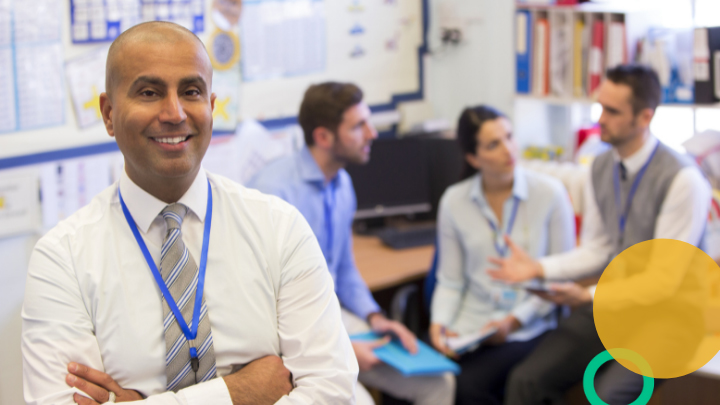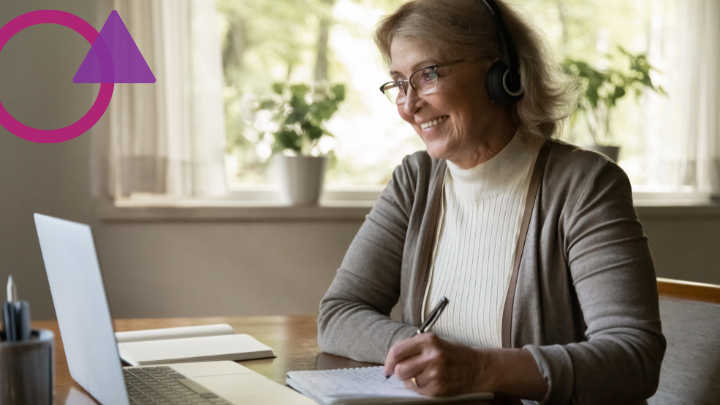School and district leaders are facing the most challenging moment of their careers: keeping their communities safe from a deadly virus, creating new virtual and hybrid structures, securing new resources, and ensuring educators have the support they need to teach in an entirely new way. It is so easy to feel overwhelmed.
Romain Bertrand has worked in education for the last 20 years as a teacher, consultant, and coach. In the last six months, he has logged 200 hours — yes, 200 — helping educators adapt to the most unusual circumstances they’ve ever faced. While facilitating interactive Virtual Workshops, Romain helps leaders stay focused on core leadership principles and identify where this moment actually opens up positive new possibilities. In the midst of unprecedented challenges, Romain relishes the role of confidant, cheerleader, problem-solver, and connector.
Recently, Romain laid out his most impactful advice for leaders, in “With School Plans in Flux, Here are Three Leadership Strategies to Prioritize – And 2 to Avoid” The big takeaways? Create a unifying vision for learning, lead with actionable empathy, and build bridges between different people’s perspectives. (Read the piece to find out what to avoid!)
Romain struck similar themes recently on the inaugural episode of The Time for Teachership podcast, hosted by BetterLesson coach Lindsay Lyons. Lindsay is a leadership scholar who wanted to get Romain’s take on how leaders can manage this extraordinary moment: how to find your focus, keep what’s working and discard what’s not, and support teachers through it all.
The following is an excerpt from the podcast.
Lindsay Lyons: Romain, what’s your vision for schools? What’s the dream that you hold on to when you think about what education could be?
Romain Bertrand: When I think about my vision for schools, I think about an evolution I made from focusing on closing the achievement gap to closing the opportunity gap. For many years I taught in schools that had diverse student populations but would be segregated by courses. Within that one school, you could clearly see this achievement gap playing out – the majority of students in Advanced Placement courses were white, while the majority of students in the non-honors math and ELA classes were students of color. And so my first reaction was to say, well, we’ve got to work really hard at closing this gap. We have to figure out how we can support them.
But then some people helped open my eyes to the fact that when we focus on the achievement gap, we are actually focusing on the product of a systemically racist system. And so the solutions we employ are not really trying to dismantle the system. If anything, they actually use measures of success that are already racist.
For example, trying to increase standardized test results by 40% in a year – we know that this is not really possible. Or if it’s possible, it’s not going to be done in a way that is transformative. It might look good on the school’s report card, but it’s not really going to dramatically change the trajectory and experience of the student.
So I think the biggest reframing for me has been going from focusing on closing the achievement gap to closing the opportunity gap. Instead of looking at deficiencies, you start looking at the opportunities that you are not offering. How do your biases manifest themselves in the school, particularly for your students of color?
And in some way, when you start tackling this question, you can start really reframing the debate and dream about a different education system with very different foundations from the one we have now, as opposed to trying to close the gap within the very narrow frame of the current system we have in place.
Lindsay Lyons: I love that answer because it takes us back to thinking about why we’re even involved in education. What is the goal here? And I love the idea of determining that with all of your stakeholders, with the community.
In terms of what you’ve been talking to leaders about lately – I’m sure you’ve gotten a lot of questions about how leaders can support teachers at this time. What’s your advice?
Romain Bertrand: First of all, it’s important to acknowledge how difficult a time it’s been for school leaders. All of the constantly changing conditions have created an enormous amount of stress, with no break. I see that this weight makes it difficult to approach this time also as an opportunity. And I’m not trying to find a silver lining to the situation because it’s a very difficult situation. But it’s also a moment to pause and say, okay, well, we have to do things a bit differently. We don’t have a choice. The schedule is going to look very different.
So could it be an opportunity to really think about what we would like to do? What’s our vision for quality learning and what does that vision look like in a moment like this?
And if we do that, you’re going to find some challenges, you’re going to be like, oh, in our vision for student learning, quality conversation between students and authentic collaboration is key. If all of a sudden, you have to start from a distance, or in a hybrid schedule with students in the classroom being apart physically, all of this creates barriers to your core idea. And so it’s easy to just say, you know what, we’re going to put it aside for now and we’re just going to try to do the best we can because that cannot be one of our priorities, right?
But I think the irony of this moment is that there are new opportunities right now – technology that we have finally decided to give a try, or using a different type of schedule, for example. When you help people focus on their vision, they can see certain things that they couldn’t before.
All of a sudden we’re discovering that our students can do a lot more than we thought they could do, and teachers as well. We are unlocking possibilities.
My main focus right now is to try to help people continue to work toward their core vision for quality learning, trying to help them realize that the school they have created does not have to disappear due to this moment. And if anything we should continue to travel within it into this new reality.
Lindsay Lyons: Do you have any tips for leaders who are taking on that instructional leader role this year and want to really home in on what that looks like to be an instructional leader for their teachers?
Romain Bertrand: So, to me, it starts with liberating yourself from the obsession with numbers when it comes to standardized testing. There’s a really huge amount of pressure placed on school leaders around standardized testing. And that amount of pressure is not the same if you are the school leader in a school with a majority of students of color vs a school with a majority of white students. The consequences of not meeting your numbers are not the same.
So unfortunately I often see school leaders visioning too much with a number in mind. That translates to, “This year, we’ll see X percent of students proficient, or you will see Y percent of students growing, or will see an improvement of Z percent over this or that metric.” And – I’m not against that. I think it’s important that we keep in mind that we have to have high expectations for students in that they should be growing in relation to different measures.
But right now we’re focusing only on one and that’s a problem. What we need to really spell out is how do we want our students to learn? What kinds of learning experience do we value? What skills do we value growing in our students?
Because I think that it is your way to actually achieving results. You don’t do it just for the results – you do it because you want to lead a school, you want to create a space that has a personality, that has a history, that is a community. And if you do this well, results will follow, but the first thing to do is to think about redefining who we are, what we believe in.
The second piece of advice that I would give is, once you have extracted these big ideas, start thinking about what they can mean concretely in how students will experience this year as we might be shifting from distance learning to a hybrid schedule, to being back in the building.
So let’s take a very concrete example. Let’s say you decide that, regardless of where we are, we feel like our students should be collaborating every day.
Then how does collaboration look in distance learning – when we meet students synchronously or are working asynchronously? How do we support teachers to continue to have collaborative spaces? We can’t use the excuse of distance or technology because we actually know that there is enough out there to figure out ways to do this, but we have to support teachers, we have to support students who don’t have access to the technology or to quality WiFi and then we have to teach the skills and the tools necessary to be able to do it.
And that takes work. But that’s what’s beautiful.
And if you focus that work on collaboration from a distance, the day you move half of your kids to the classroom or all of your kids to the classroom- guess what? They will carry all these skills with them to the classroom.
We have to help educators break down their vision and make it concrete in the virtual space. Or make it concrete in the physical space and try to see the connection.
Lindsay Lyons: I really resonate with that. As a coach, my job is to help people see possibilities. One of the most common things I hear is, well, we would do a think, pair, share, here and I can’t do that at a distance. So I’ll help them think it through- okay, do you have access to break out rooms? How about we do Google Doc commenting? Maybe a student doesn’t want to write, they’re struggling with written language? What if we use Vocaroo as a tech tool and add the audio link in the Google Doc? Just starting with what did this look like in the physical classroom helps people brainstorm what COULD this look like in the virtual classroom.
Romain Bertrand: Right. The trick is not to replicate exactly what was happening in the physical classroom, especially if it wasn’t a good idea in the first place. I have heard of teachers who put kids in individual break out rooms while they do their independent work, but without swinging by the room to have a check-in or 1:1 time. Is this an effort to replicate a class where students work independently at their desks and can’t leave the room without a pass? But this is not necessarily a practice we want to replicate.
With what we’re living through right now, kids more than ever should be collaborative. They miss their peers and never get to work with them. The other day, I heard of a teacher who created a simple slide to open class every day. It has a timer counting down, some music playing, and some nice encouraging messages to students and prompts for chit chat or questions to ask each other. It starts 5-7 minutes before class really starts. The teacher said that since she started doing this, more students are showing up on time. It makes them feel a part of a community. So that replicates what students need from the old model, without trying to replicate what they don’t.
Teachers are doing a lot of this by themselves – they are very creative and will figure it out. But we have to support them better and much more.
Lindsay Lyons: I’m thinking about teachers or leaders who are wondering, how am I going to do observation this year? What does that even look like, what do I prioritize? If we say culturally responsive teaching is important to us, or collaboration is important to us, but then we don’t actually measure that or make that meaningful for an evaluative formal thing, that really doesn’t align our values with our actions. What would you recommend leaders think about beyond the numbers? What should they look for in class?
Romain Bertrand: We have to be extremely careful this year. We can use a classroom analogy – any good teacher would not want their students to be blindsided by what’s on the summative assessment. Unfortunately, schools do have to worry about evaluations right now, for compliance reasons.
But the major flaw right now is we have to already think about evaluation, but we haven’t really created a tool that helps teachers self-assess in relation to distance learning, to be able to see, “Okay, these are the expectations for this. This is where I’m at. This is how I could get better. And this is how you [my administrator or my coach] could help me.”
So we have to make sure, first and foremost, that we reintroduce systems of self-assessment and support systems of professional development before we think about evaluation.
I’ve created a tool that I use with leaders in workshops or an individual strategic planning session where I help them break down their vision into what they want to see. We help them identify, what are you looking for in a classroom? What do you want to see students doing? And then, what do we want to see from asynchronous learning? And honestly, the first thing that comes to their mind when they do this exercise is not really evaluation. It’s “oh, this is what’s possible, and teachers could be doing this!”
And if there was ever a year to really do away with random walkthrough in a classroom, it’s this year. Instead, ask teachers: What is a good moment to come tomorrow? And during that moment, what are you interested in me paying attention to? What feels challenging right now? What are you trying to improve during your live meetings with students? When you talk to a teacher briefly before going to see them and ask them what they want to get better at, most of the time they’ll tell you. And then you can create these look-fors, and you can also realize when they’re not even imagining that something can be possible in the medium.
Lindsay Lyons: We talked about a lot of things, but if you could just pick one thing that a leader could start with tomorrow to really support teachers to live in alignment with this value of racial justice and culturally responsive teaching, what would that one thing be?
Romain Bertrand: We have to create a culture of comfort around critical conversations about race and racism. We have to model that work ourselves as a leader with our staff. We have to create spaces where teachers can start having conversations around, how is our system racist or inequitable and what does it mean to talk about that without people feeling that they’re a horrible person and tensing up and closing up because of that.
This is not an easy thing to do yourself if you’ve never done it. There are many organizations now, including BetterLesson, who are offering workshops that can really help. Some of the strategies that we coach educators on include Cultivating Critical Consciousness by Reflecting on a Lesson or Unit, Having Conversations about Challenging and Controversial Topics, and Building Equity Awareness and Capacity.
Lindsay Lyons: I love the priority there on learning – modeling discomfort in the learning journey as a leader and really making space for adults to learn as a staff. Because that’s what we’re asking students to do every day – come in, be uncomfortable, and grow.
Romain Bertrand: Exactly. Try to create a culture of coaching. People feeling comfortable receiving feedback from leaders and peers, people feeling comfortable helping others grow at something that they’re not yet an expert in. Try to create avenues for people to open the doors of their classroom, to invite in peers or go see their peers and invest in each other. A school leader that can invest in creating a culture of coaching can really transform the school.








